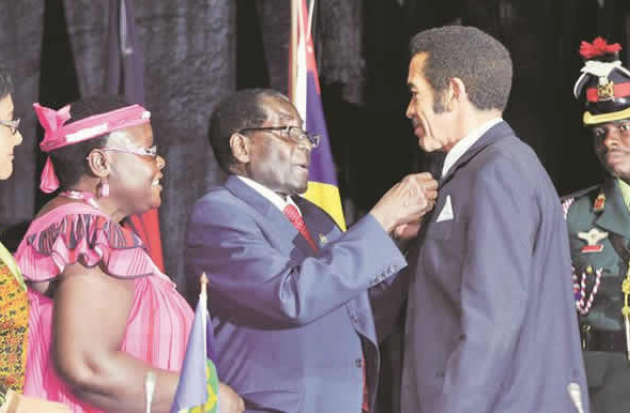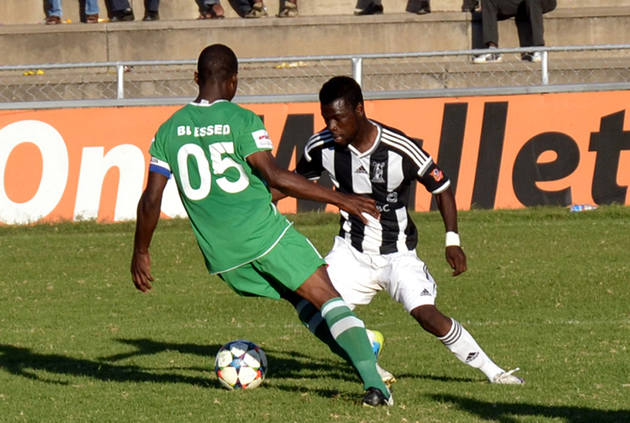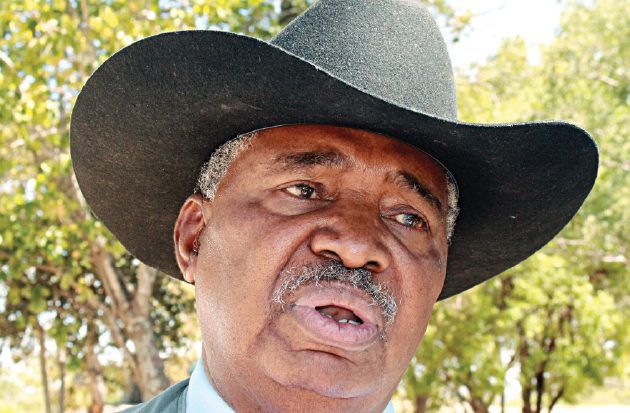You fought a good fight Mr President


President Mugabe handing over the Sadc chairmanship to Botswana president Seretse Khama Ian Khama last week
Tafara Shumba
AS the reins of the Southern African Development Community (Sadc) exchanged hands last week, it is worthy to reflect on the political and socio-economic achievements that the regional bloc scored under the stewardship of an African icon, hero, statesman, role model, Pan-Africanist, great teacher, revolutionary and father of Africa.
President Robert Mugabe handed over the Sadc chair to Botswana President Seretse Khama Ian Khama after the expiry of his one-year term.
He stepped down a satisfied man, having scored monumental feats in the socio-economic and political fronts.
President Mugabe fought a good fight for the region. He has been riding high since he took over the Sadc chair at the 34th Summit in Victoria Falls.
During President Mugabe’s tenure, Sadc managed to calm potentially volatile spots in the region and set forth the agenda for regional economic transformation and sustainable development.
When President Mugabe took over the Sadc chair, the regional bloc was battling with three hotspots in the region, namely the Democratic Republic of Congo (DRC), Lesotho and Madagascar.
However, during President Mugabe’s tenure, Sadc supported mediation, peacekeeping, peace building and post-conflict reconstruction and development in response to the political and security challenges in these troubled spots. Because of this effort, Sadc remains the most peaceful region in Africa.
Following the political and security developments in Lesotho, Sadc under the leadership of President Mugabe deployed a fact-finding mission headed by South African Deputy President Cyril Ramaphosa.
Sadc also assisted the kingdom to undertake constitutional and security sector reforms. Through these efforts, the political and security normalcy were restored in the kingdom.
When President Mugabe took over the leadership of Sadc, the political and security situation in the DRC was volatile. The communities in the north-eastern territories had been terrorised and witnessed brutal killings carried out by the Uganda rebel group, the Allied Democratic Forces-National Army for the Liberation of Uganda (ADF-NALU).
Sadc managed to assist the DRC government to calm the situation. President Joseph Kabila agreed to call for a national dialogue with political parties, civil society and the international community as the country prepares for the local and municipal elections on October 25, senatorial elections on January 17, 2016, parliamentary and presidential elections on November 27, 2016.
Sadc also deployed troops under the Monusco Intervention Brigade to restore security in eastern DRC. The effort enabled FARDC to neutralise FDLR.
The parliament of the Republic of Madagascar attempted to impeach President Henry Rajaonarimanpianina on May 26 over a litany of allegations that included constitutional violations and obstructing the establishment of an Independent Electoral Commission.
However, the Consitutional Court ruled that the impeachment proceedings did not have a legal foundation.
Sadc assisted in developing a post-conflict programme on security sector reform (SSR).
Sadc undertook serious military exercises during President Mugabe’s tenure that will enhance the regional operational capacity in collective defence.
It was also during his term that the idea of establishing a Sadc Standby Force (SADCSF), which aims at countering modern-day threats, was given impetus.
Since the events of terrorist attacks in Tanzania and DRC, Sadc began to view itself as a target of active international and local terrorism.
In view of that, the visionary chairman initiated the development of a regional counter terrorism strategy in collaboration with the African Centre for the Study and Research on Terrorism (ACSRT), the Committee of Intelligence and Security Services of Africa (CISSA) and the United Nations Counter Terrorism Centre (UNCTC).
During President Mugabe’s tenure, Sadc consolidated democracy in the region, with six member states successfully holding credible, peaceful, free and fair elections.
These are Mozambique where President Filipe Jacinto Nyusi of the Frelimo party romped to victory.
In Botswana, President Khama of the Botswana Democratic Party was retained while President Hage Geingob of the Swapo party won the presidential and national assembly elections in Namibia. Prime Minister Aneerood Jugnauth of the Alliance Lepep won the elections in Mauritius.
President Edgar Chagwa Lungu of the Patriotic Front also won in the Zambian presidential elections, so was Prime Minister Pakalitha Mosisili of the Democratic Congress-led coalition in the Kingdom of Lesotho.
On the economic front, the major highlight of President Mugabe’s tenure centred on the industrialisation and beneficiation drive. His successor admitted during the recent Sadc summit in Botswana that the industrialisation agenda was the brainchild of President Mugabe.
“During his tenure, Sadc adopted the industrialisation strategy and roadmap and I think it’s true to say that it indeed was his idea that we embark on this as well as the Revised Regional Indicative Strategy Development Plan…,” said President Khama.
The Industrialisation Strategy and Roadmap, adopted in April this year at an extraordinary Summit in Harare, is fundamental in poverty mitigation and economic emancipation of the people of the region.
Africa is generously endowed with natural resources.
For instance, 55 percent of the world diamond and 72 percent of the world platinum group metals come from the Sadc region.
Despite these fortunes, the region is home to the world’s poorest people. Seventy percent of Sadc citizens live below the poverty datum line.
The export of raw materials from Sadc is compromising the development of the region’s industries.
The beneficiation of the regional natural resources could finance socio-economic developments in the region.
It is through beneficiation and value addition that Africa could unlock real value from its resources. President Mugabe is the pacesetter as he had already embarked on the beneficiation of such minerals as platinum and diamonds. It is his vision as enshrined in the Zimbabwe Agenda for Sustainable Socio-Economic Transformation (Zim-Asset) to harness the full potential of his country’s varied natural resources.
Currently, beneficiation is largely done outside the region and it is those countries that are benefiting.
President Mugabe has rightly said: “It’s through adding value to our products that we can make the first step. If we continue as net exporters of raw materials, we’re sure to remain trapped in the jaws of underdevelopment while those who add value on our behalf flourish at our expense.”
The success of this vision of transforming the region into a self-sustaining region depends on the funding system.
As President Mugabe aptly noted, Sadc cannot expect the West, which is benefiting from the status quo where the region is the exporter of raw material, to finance this endeavour of weaning itself from the unequal relationship in which they (West) dictate the terms of trade.
It was also during President Mugabe’s tenure that a grand Tripartite Free Trade Area (TFTA) involving Sadc, Common Market of East and Southern Africa (Comesa) and East Africa Community (EAC) was launched.
The objective behind the TFTA is to boost intra-Africa trade that currently stands at a 12 percent, a miserly percentage as compared to 55 percent in Asia and 70 percent in Europe.
The TFTA will reduce the cost of doing business in the region, as it is cheaper to have one trade regime, which will enhance economic inter-linkages and enabling business environments.
President Mugabe did his best to take Sadc back to the founding principles. President Khama should build on this success story of the only serving President who was there when the bloc was formed.











Comments